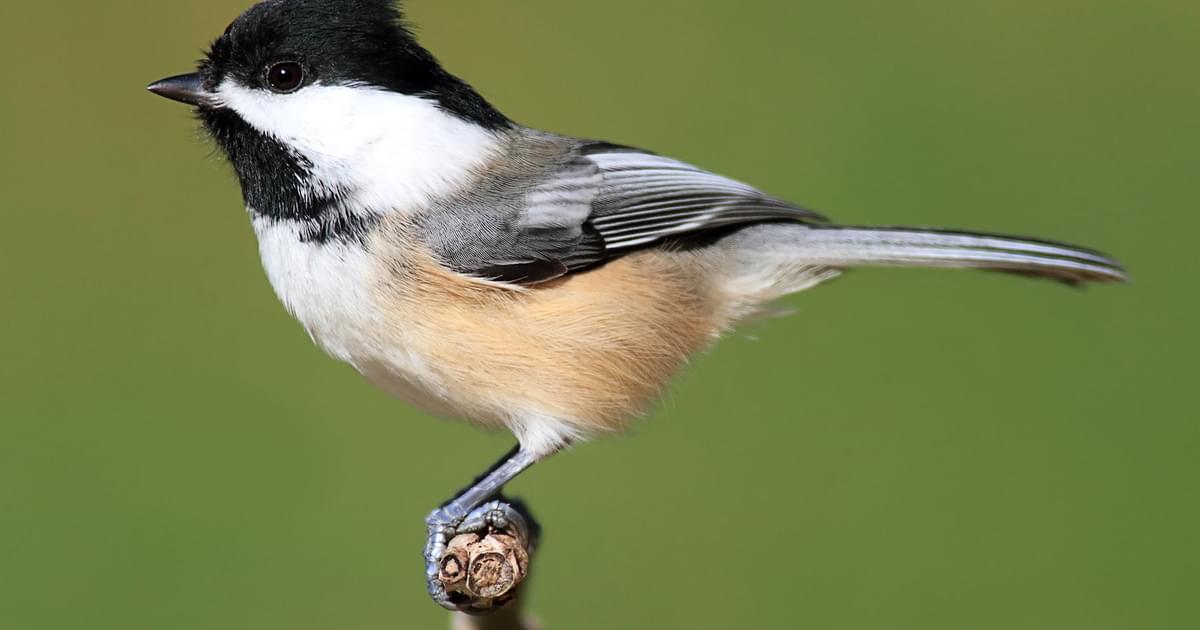Male and female black-capped chickadees can be told apart by their behavior and vocalizations. Black-capped chickadees are one of the most beloved birds in north america, known for their curious and friendly nature.
These small, gray birds with black caps are common backyard visitors, especially in the winter months. However, telling male and female chickadees apart can be a bit tricky. While they look very similar, there are subtle behavioral and vocal differences between the sexes.
In this article, we will explore these differences and help you identify these charming little birds with more confidence. So, let’s dive in and learn how to tell male vs female black-capped chickadees apart!

Credit: birdfact.com
Physical Characteristics Of Male And Female Black-Capped Chickadees
Male Vs Female Black-Capped Chickadees: How To Tell Them Apart
Have you ever tried to spot the differences between black-capped chickadees? These birds are fascinating creatures, and it can be challenging to tell them apart, especially between males and females. However, there are some key physical characteristics that distinguish them from each other.
In this post, we’ll discuss the physical differences between male and female black-capped chickadees.
Understanding The Physical Differences In Male And Female Black-Capped Chickadees:
Male black-capped chickadees:
- Males have a prominent black cap that covers the top of their heads, extending down to their eyes and throat.
- They also have glossy black feathers on their chin and upper chest, with white feathers on their lower chest and belly.
- Males tend to be more prominent, with larger and thicker necks.
- They usually weigh between 9.5 and 12 grams.
Female black-capped chickadees:
- Females have a black cap too, but it’s not as prominent as the male’s. The black cap doesn’t extend down to the throat.
- Their throat is usually white, and their chest and belly are a lighter gray than males.
- Females tend to have smaller necks and be less prominent than males.
- They usually weigh between 8 and 10.5 grams.
Remember, these differences are minor, and it can be challenging to distinguish between males and females. Therefore, it’s always better to study them to identify them correctly.
Overall, black-capped chickadees are delightful birds to watch. Understanding their physical characteristics can help you appreciate their differences, and hopefully, you can spot the differences between males and females next time you come across them in the wild.
Behavioral Differences Between Male And Female Black-Capped Chickadees
Male Vs Female Black-Capped Chickadees: How To Tell Them Apart
The black-capped chickadee is a small, non-migratory songbird that is found throughout the forests of north america. While male and female chickadees look similar, there are subtle behavioral and physical differences between the two. We will explore the behavioral differences between male and female black-capped chickadees.
How To Tell Male And Female Black-Capped Chickadees Apart Based On Their Behavior:
Male and female black-capped chickadees have distinct behaviors that can help in distinguishing between the two. Here are some characteristics that can help:
- Singing: Male chickadees sing more than females. They sing to establish dominance and attract a mate. Listen for their distinct “fee-bee” song.
- Foraging: Male chickadees forage in the upper parts of trees, while females forage in the lower parts. The reason for this difference is to reduce competition for food.
- Territorial behavior: Male chickadees are more territorial than females. They establish and defend their territories aggressively. They are particularly aggressive during the breeding season.
- Nesting: Female chickadees typically select the nesting site and construct the nest. They will also do most of the incubation of the eggs and caring for the young.
- Aggression: In general, male chickadees are more aggressive than females. They will compete for food and territory. They will also chase away other birds that enter their territory.
Physical Differences Between Male And Female Black-Capped Chickadees:
While male and female chickadees look very similar, there are some minor physical differences that can help differentiate between the two. Here are some of the physical characteristics:
- Size: Males are slightly larger than females, with a longer beak and a slightly larger head. They are also generally heavier than females.
- Plumage: Male chickadees have slightly brighter and more vibrant plumage than females. The white areas on their cheeks are also larger and more distinct.
The behavioral and physical differences between male and female black-capped chickadees are subtle. However, paying attention to these differences can help bird enthusiasts distinguish between the two more easily.
Studying Male And Female Black-Capped Chickadees In The Wild
Male and female black-capped chickadees may look nearly identical, but there are actually several differences that distinguish them from one another in the wild. To successfully identify and study these different characteristics, it’s essential to be patient and observant. We’ll explore some of the most effective techniques for studying male and female black-capped chickadees in their natural habitats.
Techniques For Identifying And Studying Black-Capped Chickadees In Their Natural Habitats:
- Plumage difference: The most substantial difference between male and female black-capped chickadees is their plumage. Male birds exhibit a more prominent, glossy black cap, whereas female birds show a duller grey cap. In addition, male black-capped chickadees tend to have richer, darker plumage around their eyes and neck. Utilizing binoculars or a spotting scope can help researchers differentiate between these subtle plumage differences.
- Vocalization: Black-capped chickadees sing different songs based on their gender. Male birds produce a two-note whistle, whereas female birds vocalize a three-note call. Nature enthusiasts can use this vocalization difference to help in identifying the bird’s gender accurately.
- Courtship behavior: Another useful technique to determine black-capped chickadee’s gender is by observing their courtship behavior. During the breeding season, males will often chase females, and the males will also exhibit wing flicks and other courtship displays to attract mates. Observing these courtship displays can offer important insights into the birds’ life-cycle and reproductive behaviors.
- Nestbox studies: Nestbox studies can also be a valuable technique for studying black-capped chickadees’ gender and behavior. Researchers can peak into the box and observe who brings nesting material, which chickadee sits on eggs during incubation, and which bird tends to the young after hatching. By keeping a journal to record how often each bird cares for the young and examining their behavior, researchers can determine gender based on the birds’ parental roles.
- Dna analysis: Although dna analysis is not as practical or frequently implemented in studying black-capped chickadees’ gender, it is still a useful technique. Researchers can collect feathers or blood samples from the birds and perform dna analysis to determine the gender of each bird accurately. This method can reveal important insights into black-capped chickadees’ genetic variations and population demographics.
As bird enthusiasts, scientific researchers, and conservationists continue to explore the fascinating world of black-capped chickadees, using these techniques to identify and study these unique birds’ differences in their natural habitats is essential for gaining useful insights into their behavior, reproduction habits, and life-cycles.
Frequently Asked Questions On Male Vs Female Black-Capped Chickadees: How To Tell Them Apart
How Do You Tell The Difference Between Male And Female Black-Capped Chickadees?
The male black-capped chickadees have a black cap that extends down to their eyes and throat with white cheeks, while the females have a smaller, grey-brown cap and pale cheeks.
Can Black-Capped Chickadees Change Their Gender?
No, black-capped chickadees can’t change their gender or sex. Male and female chickadees have different physical and behavioral characteristics, such as size, plumage, and singing, that identify their gender.
Do Male And Female Black-Capped Chickadees Behave Differently?
Yes, male and female black-capped chickadees have different roles in reproduction. The males sing to court the females, share food with their partners during courtship and incubation, and defend their territory. The females build the nest, lay and incubate the eggs, and care for the young.
Do Black-Capped Chickadees Mate For Life?
Black-capped chickadees don’t mate for life. They form monogamous pairs that last for a breeding season, but they may switch partners in subsequent years. In some cases, some males may mate with more than one female and contribute to multiple broods.
How Does Aging Affect The Appearance Of Black-Capped Chickadees?
Black-capped chickadees’ plumage may show signs of aging, such as a duller and more worn-out look, and a paler cap and underparts. However, their markings usually remain the same throughout their adult life.
Conclusion
Identifying male and female black-capped chickadees can seem like a daunting task for someone new to birdwatching. However, once you know what to look for, it can become quite simple. Males and females have subtle but distinct differences in plumage, behavior, and vocalizations.
Aside from their physical differences, they also have unique roles in the breeding and nesting process. Understanding these differences can enhance your birdwatching experience and help contribute to scientific research. By paying close attention to the behaviors and characteristics of male and female black-capped chickadees, you can gain a deeper appreciation for these charismatic birds.
So, get out there, observe some chickadees, and see if you can spot the differences between the males and females!
Latest Posts
The Ultimate List: Top 8 Best Birdwatching Podcasts for Avid Birders
Looking for the top birdwatching podcasts? Here are the eight best options to tune into today! Birdwatching can be a thrilling, immersive experience that brings...
Stop Squirrels in Their Tracks: 10 Effective Ways to Safeguard Your Bird Feeder Pole
To prevent squirrels from climbing your bird feeder pole, use squirrel baffles and slippery poles. Here are ten effective ways to keep squirrels from stealing bird food and damaging bird feeders. ...


